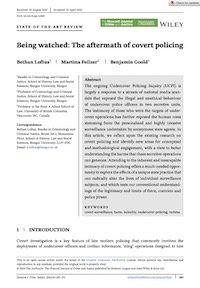By Hina Kalyal Swaleha Naqvi, PhD Volunteer Researcher Nadia Asjad
The impetus behind this report was the death of George Floyd at the hands of a police officer in the United States, triggering global protests against police use of force. In response to the public reaction, many police organizations across North America are now reflecting on their treatment of people of color and devising measures to improve the relationship. The London Police Service is one of the first few police organizations in Canada that have voluntarily undertaken a research project on systemic racism to better serve the culturally and ethnically diverse community of London, Ontario. The specific objectives of the project were: To identify whether service gaps/differences exist during police interactions with White versus the Black, Indigenous, and People of Color (BIPOC) community members of London, Ontario. To determine whether any systemic barriers exist within the LPS that might impact the professional growth and development of BIPOC members; and to conduct an Employment Systems Review to determine whether the current policies Context of the Report The impetus behind this report was the death of George Floyd at the hands of a police officer in the United States, triggering global protests against police use of force. In response to the public reaction, many police organizations across North America are now reflecting on their treatment of people of color and devising measures to improve the relationship. The London Police Service is one of the first few police organizations in Canada that have voluntarily undertaken a research project on systemic racism to better serve the culturally and ethnically diverse community of London, Ontario. Research Objectives The specific objectives of the project were: To identify whether service gaps/differences exist during police interactions with White versus the Black, Indigenous, and People of Color (BIPOC) community members of London, Ontario. To determine whether any systemic barriers exist within the LPS that might impact the professional growth and development of BIPOC members; and To conduct an Employment Systems Review to determine whether the current policies and procedures followed by the LPS are equitable and fair to all members of the LPS. Research Design The project was divided into three phases. In Phase I, public opinion was sought regarding their interactions with the members of the LPS through in-depth interviews with the BIPOC members of the community, followed by an online survey. In Phase II, interviews were conducted with BIPOC members of the LPS regarding their views about the organizational culture. The interviews were followed by an online survey administered to all members of the LPS. In phase III of the project, an Employment Systems Review (ESR) of LPS human resources policies and procedures was conducted to identify any barriers that may be impeding the progress of BIPOC members in their careers within the organization. Phase I Findings The analysis of interviews conducted with the BIPOC community members during the first phase of the project yielded themes that indicated that police officers were generally impolite and dismissive, relied on stereotypes while interacting with the BIPOC community, and occasionally used excessive force. The survey results highlighted similar themes. However, there was a significant difference of opinion between the BIPOC and White community members regarding the officers of the LPS with the BIPOC respondents showing a higher level of dissatisfaction compared to the White respondents. Phase II Findings The analysis of interviews with BIPOC members of the LPS revealed dissatisfaction with certain elements of the organization’s culture such as the bonding between White members which excluded others and the use of culturally inappropriate language. The BIPOC members also believed that they are discriminated against when it comes to career development and growth opportunities. The results of the survey, which included all members of the LPS, were interesting as the White members claimed that they were the ones being discriminated against, to accommodate diverse and women members. The White members (men) claimed that the organization was relaxing the recruitment and promotion criteria to facilitate the BIPOC members and women, at the cost of organizational effectiveness and the quality of service- delivery by the LPS. Phase III Findings The third phase of the project included an Employment Systems Review (ESR) to assess the Human Resource policies and procedures in order to determine whether any of these documents were creating barriers to the growth and development of diverse members within the organization. While the policies and procedures reviewed were consistent with the principles of equity, diversity, and inclusion outlined by the government, some minor observations were made where LPS could improve its process to enhance employee satisfaction. Summary of Recommendations Based on the findings of the three phases, the recommendations are summarized as follows: LPS should focus on developing training programs for all employees focusing on developing cultural competence and cultural humility, and organizational policies and procedures must reflect these efforts. Resources should be allocated towards community outreach programs to improve public-police relationships and enhance mutually beneficial partnerships. The recommendations of the employee interviews, employee surveys, and the ESR mainly focus on enhancing transparency in the recruitment, selection, employee development, and promotional processes within the LPS. We recommend the introduction of a Human Resource Information System (HRIS) which would streamline the aforementioned processes and enhance employee satisfaction, productivity, and retention.
London: The Project, 2024. 120p.





















